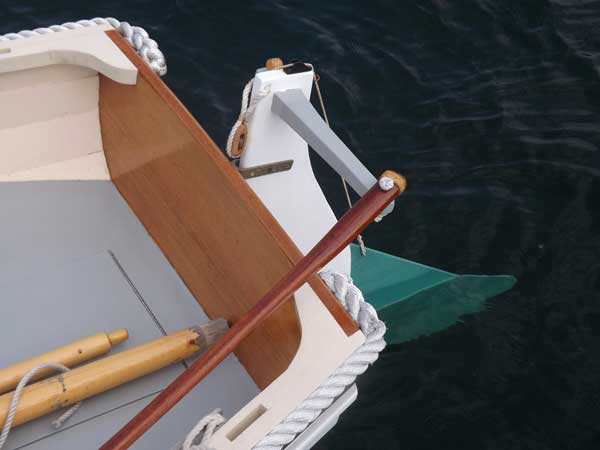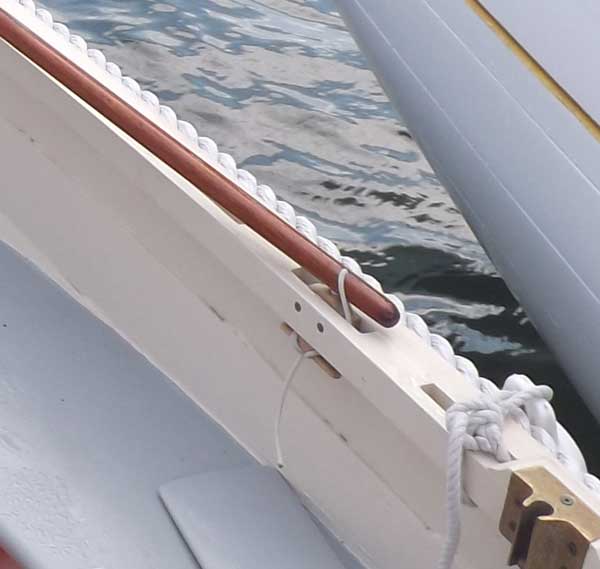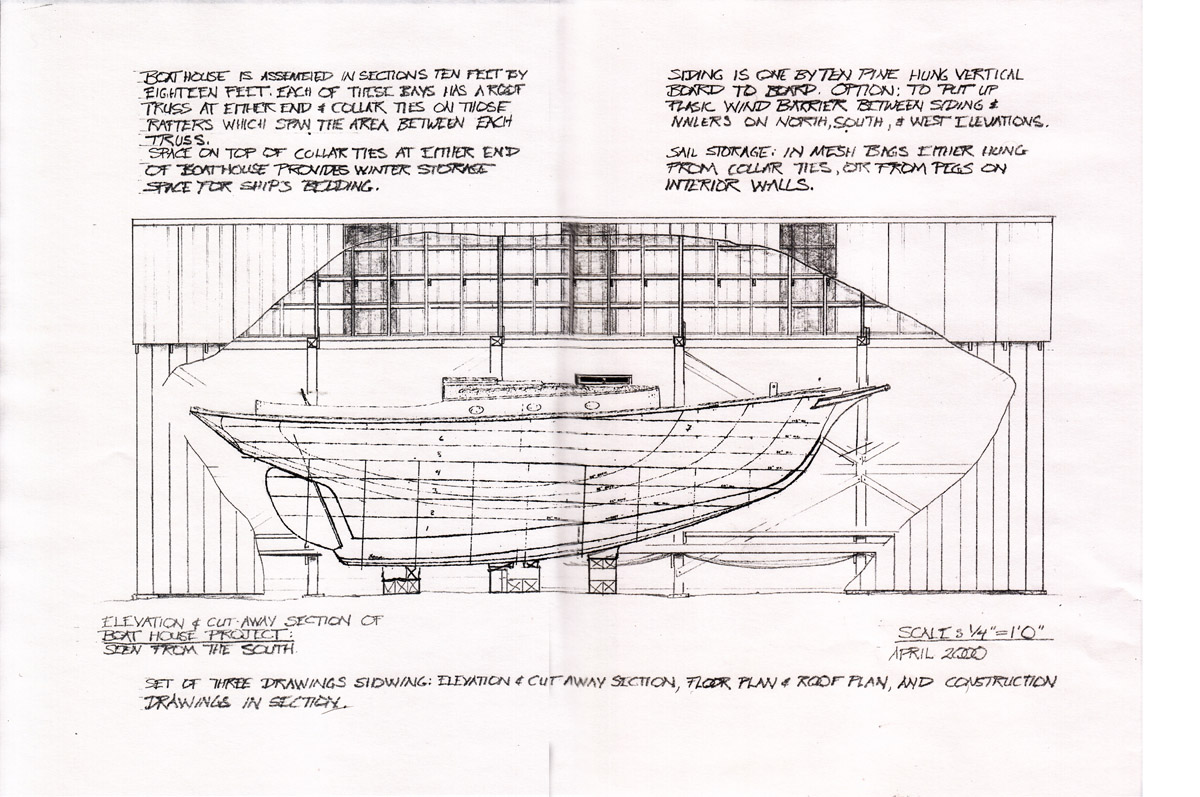This spring presented some real creative challenges for us, mostly related to our Friendship sloop.
Last fall as we got ready to decommission the boat for the season we found ourselves trying to make a rather tough decision; do we pull the engine and have it reconditioned, or do we replace the it?
On the one hand, our 28-year-old engine always starts. In all the years that we have been living with this boat, it has never failed us. On the other hand, it was developing some problems and the time to intervene was now.
I found that I was going back and forth on what to do. I don’t like working on the diesel, it is about the only thing about working on the boat that I don’t take much satisfaction in, my strengths do not include being a diesel mechanic, so rebuilding, or reconditioning this engine would mean pulling the engine to have a professional do the work. So why is that such a stumbling block? In the first place expense. The cost to have the engine professionally reconditioned is almost half the cost of a new engine. In the second place, where would that get us? We would, in a best-case scenario have an engine that is in better shape, but is still 28-years-old and which has always been underpowered for a boat that displaces almost eleven tons. That second part is key, if you are just going to use the engine to get off the mooring or through a crowded harbor, or when the wind dies, then this is no big deal, but we love to cruise, and have been in many situations where unexpected weather conditions meant that we needed a reliable engine powerful enough to help us get out of harms way. Several close calls in the last few seasons made us realize that our old engine was operating at the very extreme edge of its capabilities. Between us, the woman who will willingly get up in the middle of the night and stand an anchor watch, and I, have more than eighty years sailing experience. You don’t acquire that kind of experience without becoming acutely sensitive to where the edge is, and when you are too close to it, and we were too close to it.
So that would seem to point us in the direction of replacing the engine, except that as I said above, I don’t like working on diesels, and at least I know our old motor, I know what is likely to go wrong and how to fix it. I have spare parts on board and the appropriate tools on board, and there is a lot of comfort in that. A new engine would mean getting to know a new power plant and perhaps having to reconfigure systems around the new engine, what would that involve?
While the choice seemed obvious, the unknown factors were making me very uncomfortable.
Last fall I started to research the answers to as many of those questions as I could. I talked with representatives of just about every manufacturer of marine diesels; I got specs on multiple engines, talked to mechanics, and spent a lot of time in the engine room of the boat measuring. Mostly I asked a lot of questions and listened to the answers.
By midwinter only three things were really clear, one was that we could indeed purchase a new diesel that was physically about the same size as the old, but that had greater horsepower. Second was that if we were going to get the most out of a new motor then a new propeller, matched to the size of the engine, the size and shape of the boat and which would, in turn determine which reduction ratio for the transmission would be needed as well. And third, that I really could not determine how many other things, like the exhaust system, or engine beds, would have to be upgraded until we made the commitment to one particular make of engine.
We began to narrow the field.
As we asked more and more specific questions the answers we got kept bringing us back to Beta Marine. While the package that they suggested was not the least expensive that we looked at, it was the most complete and would require the least number of modifications to the boat as a whole. We would need to replace the waterlock muffler, build and mount a new containment box for the engine start up panel and gauges, and it was clear we would have to move the electrical panel. None of these were, by themselves, that big a job, however, if we were going to go ahead with this then it made no sense to keep the old engine control levers which were completely worn out. With a new engine and new controls it did not make a lot of sense to keep the old control cables, so they would be replaced too. And since we were pulling the old prop and the old coupling, then removing the propeller shaft to change the cutlass bearing also made sense.
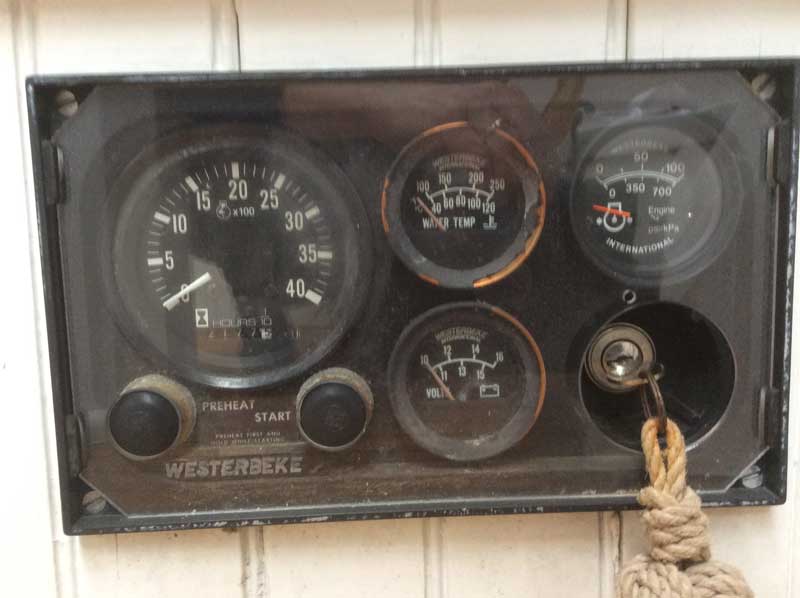
The old engine panel
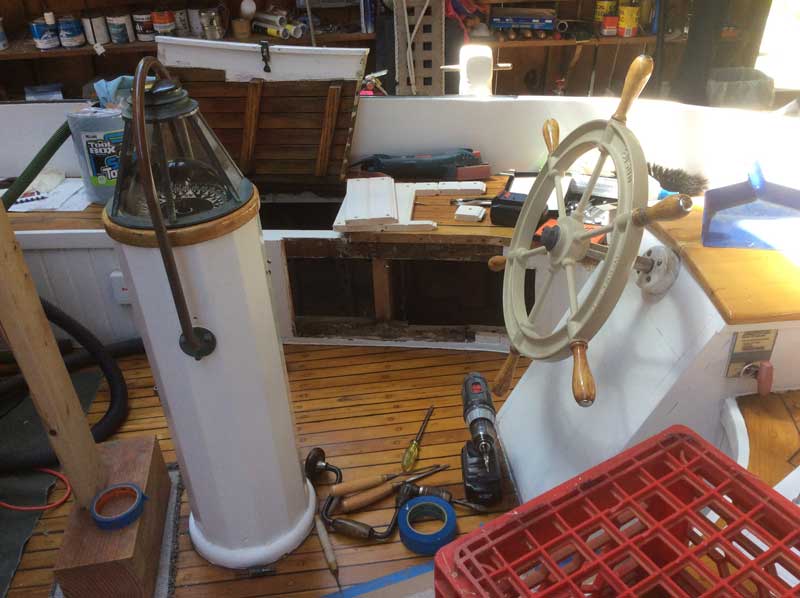
Opening up the cockpit to install the new engine panel box and remove a few soft planks at the same time.
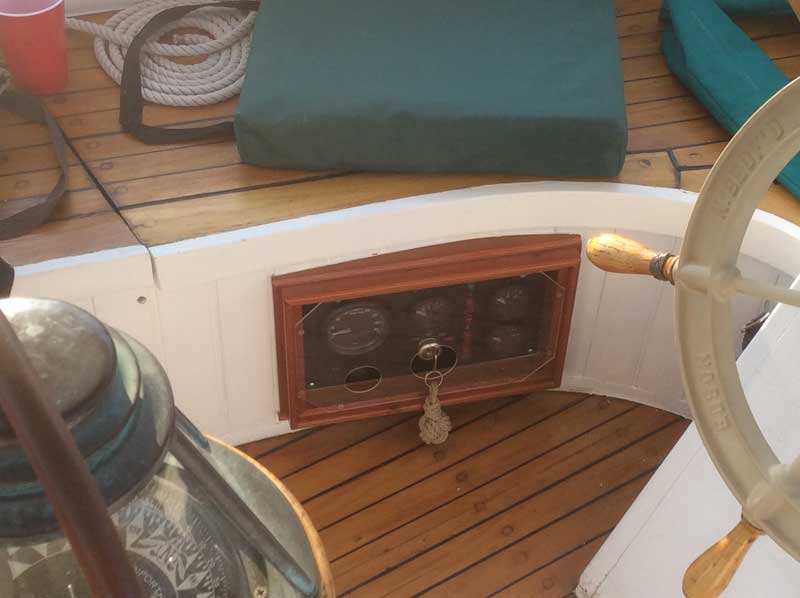
New engine box for the new panel.
As is often the case with a project like this, several jobs that I thought were going to be major hassles proved fairly easy; the engine beds for example. I worried about this a lot, but in the end it turned out that modifications were simple and quickly accomplished. The alignment was another thing I was worried about that went easily and with far less complication than I have run into in the past. On the other hand a lot of seemingly little jobs that looked easy turned into major epics. I ended up having to machine connectors for the new control levers and in the process of moving the electrical panel; it became clear that a number of connectors and wires needed replacing. All of this stuff takes time, especially when you realize to move forward you have to stop what you are working on, figure out where you are going to get a part, or parts, then wait for it to arrive. Once back to work, that is when I would discover that there were other parts I should have ordered too.
I won’t go into those epics save to say that it is the details that will kill you.
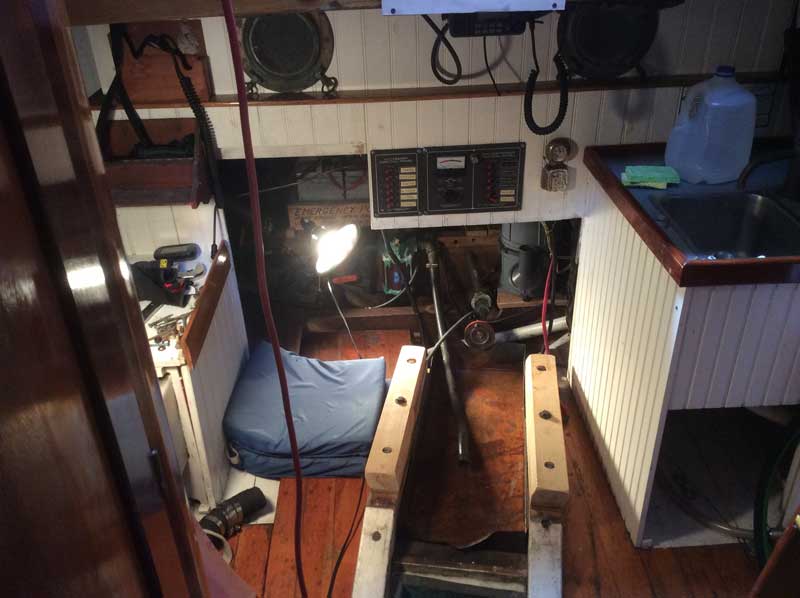
Engine beds modified to fit the new engine.

New Beta Marine 38 in place.
We have been using the engine now for almost two months and so far, touch wood, it has worked flawlessly. It is slightly larger physically than the old Westerbeke, which required a new engine cover, which also required some creative re-working of our companionway steps. However, I was able to make the box that covers the engine out of lighter materials and that makes it less of a chore to get to the engine.

New engine box (minus trim). Note the electrical panel has been moved up and into a box for easy access.
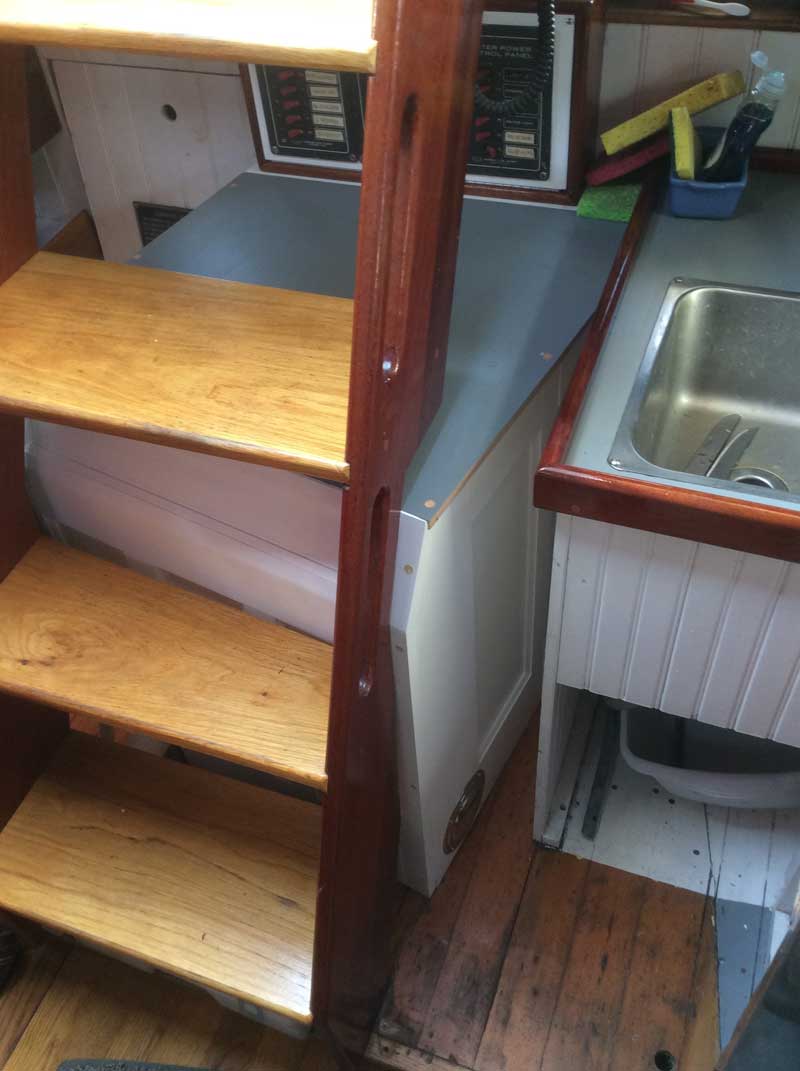
You can see here the modification we needed to make to the companionway ladder to fit the new engine box. The new engine is slightly longer than the old, and I wanted plenty of ventilation around the motor. You can also get a little closer view of the box for the electrical panel and the piano hinge along the bottom edge.
Also, when we moved the electrical panel we created a box for the panel with a hinged front. In the past if there was a bad connection in the panel, or a wire needed replacing, I had to crawl into the engine room and work directly over the engine where there was little space and it was hard to get at the back side of the panel. The new arrangement allows me to loosen two screws and the front of the panel folds down into the main cabin where there is light and easy access.
The whole project consumed more than five weeks of spare time, but we feel more comfortable on the water when conditions deteriorate (and they have already several time this season). Working with Stan at Beta Marine U.S. was easy and they were very helpful when we had questions. Later in the summer we will work on finding a new home for the old Westerbeke, but for now we are enjoying the improvements to our systems and to the engine operation.




















 involves dangerous chemicals, or results in cleanup of toxic ingredients are typically the first things to get dropped from a maintenance schedule because they are too much of a pain. And few things are more discouraging than doing all the hard work of sanding, fairing, cleaning and tacking and then applying paint, only to have that paint not hold up to the environment, fade, or peel.
involves dangerous chemicals, or results in cleanup of toxic ingredients are typically the first things to get dropped from a maintenance schedule because they are too much of a pain. And few things are more discouraging than doing all the hard work of sanding, fairing, cleaning and tacking and then applying paint, only to have that paint not hold up to the environment, fade, or peel.





